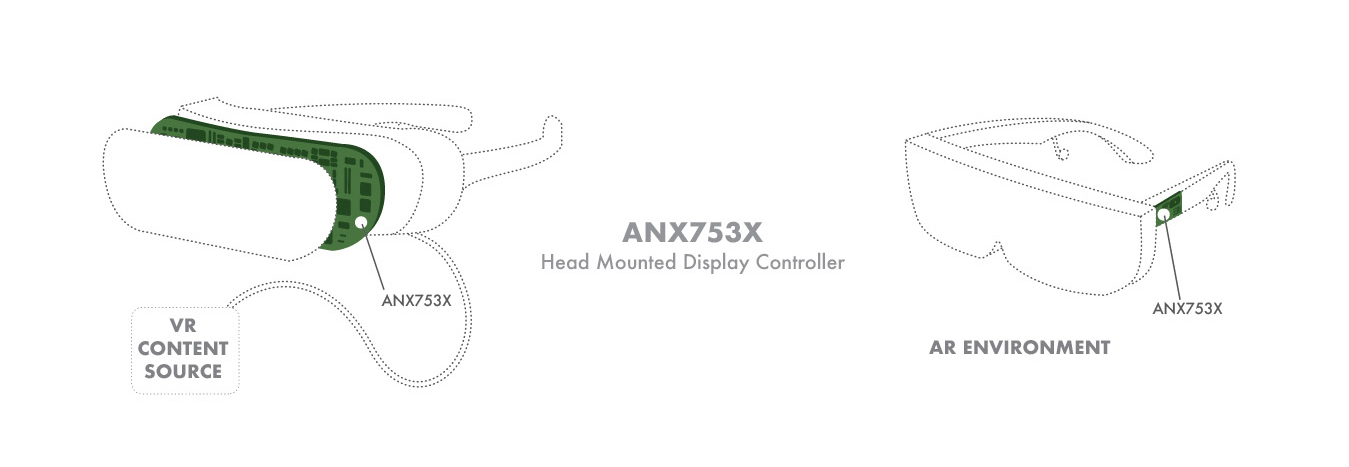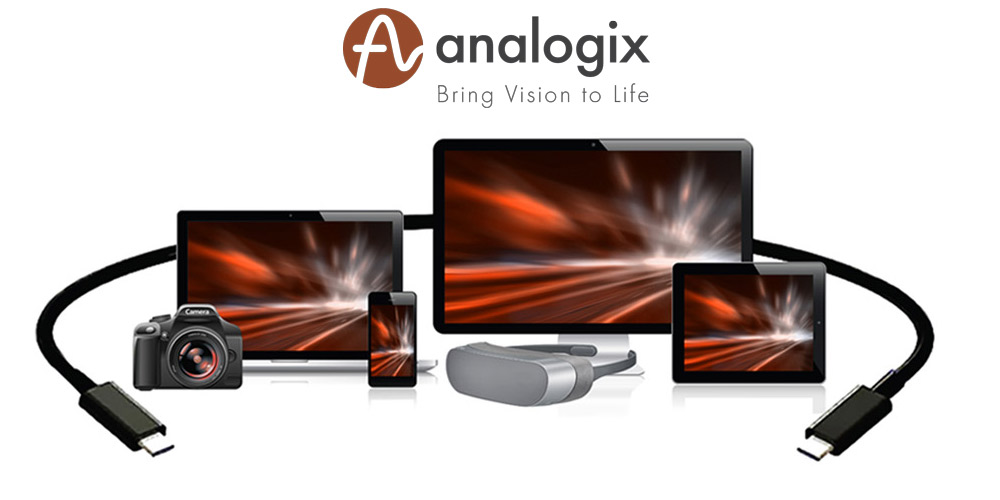Analogix is the market leader in providing end-to-end interface connectivity semiconductor solutions for DisplayPort™ under its SlimPort® brand, including high-speed signal conditioners, and an industry leader in mobile display controllers, such as low-power, high-speed timing controller solutions. Below is our interview with Michael Ching, VP of Marketing at Analogix:

Q: You’ve recently announced the ANX753x/7580 family of VR/AR head-mounted display controllers; could you tell us something more?
A: Targeted at various performance HMD applications, the ANX753x is a low power 4K Ultra-HD mobile receiver that resides inside the VR/AR HMD. It allows consumers to connect their VR/AR HMDs to VR source devices, such as the latest notebook and desktop PCs with Intel’s 8th generation processors, through a single cable and enjoy the performance of their machines at high-resolution and high transfer rates. It brings novel features which enable new connectivity channels for VR headsets: DisplayPort 1.4 HBR2 and Quad MIPI-DSI.
It is the first of its kind, fully integrated VR display chip. The ANX7530 is a unique product in its class, allowing the use of a single DisplayPort over USB Type-C cable to transfer VR/AR content from a USB Type-C enabled desktop PC, notebook, or smartphone to a VR/AR HMD. Usage of high-bandwidth capable DisplayPort technology over the USB Type-C connector will pave the way for a future that will bring 2Kx2K resolutions at 120FPS or higher per panel.
It brings value to HMD manufacturers and gives them flexibility. The ANX7530 can be used in both USB Type-C™ and non-USB Type-C applications and can manipulate a variety of video scan modes. This way, headset manufacturers have the flexibility to differentiate their products by offering the most optimized performance for a variety of applications.
- The ANX7530 supports standard DisplayPort input allowing the design engineers flexibility on the HMD input interface.
- The ANX7530 is a 4-Lane DisplayPort to Dual-MIPI output supporting up to 120 FPS. Each MIPI output has 8-DSI lanes for left-view and right-view for a total of 16-DSI lanes per device to drive today’s high-performance VR panels, ideal for popular VR panel resolutions including 1920×2160 per eye.
- The DisplayPort 1.4 receiver has configurable 1, 2 or 4-lane input supporting HBR2.5 (6.75Gbps), HBR2 (5.4Gbps), HBR (2.7Gbps), and RBR (1.62Gbps) data rates. It also supports horizontal left/ right line splitting, 3D stereo modes and HDCP2.2, as well as HDCP1.4, with an input bandwidth supporting resolutions up to 4K x 2K.
- Virtual reality systems are defined by their display quality in terms of the pixel density and responsiveness to head movement. A fluid virtual experience can only be achieved if the video is updated faster than the brain can process it, and with pixels smaller than the optical receptors in the retina. This drives video resolutions and refresh rates ever higher.
- Widespread adoption of HDCP 2.2 contributes to the growth of the entire video ecosystem by helping content providers to monetize their investments in creating more premium 360 degree and 3D material.
- The ANX7530 can be used in USB Type-C™ and non-USB Type-C applications and can manipulate a variety of video scan modes. This gives headset manufacturers the flexibility to differentiate their products by offering the most optimized performance for the markets they serve, whether that is gaming, 360 degree and 3D movies, or AR productivity.
Here are a few examples of different configurations of VR HMD connectivity that the ANX7530 enables:
– VR HMD design with USB Type-C input connected to a VR source with native USB Type-C port such as smartphone, tablet, and notebook through a Full-function USB Type-C cable;
– VR HMD design with USB Type-C input connected to a VR source such as a DisplayPort PC through an USB Type-C adapter and a Full-function USB Type-C cable;
– VR HMD design with USB Type-C input connected to a VR source such as an HDMI PC through an USB Type-C adapter and a Full-Function USB Type-C cable;
– VR HMD design with HDMI input connected to a VR source such as a legacy PC or notebook with DP/HDMI/USB output through a DP/HDMI/USB custom cable.
 Recommended: Swift Navigation: Building An Autonomous Future Through Smart Vehicle Positioning And Navigation Technologies
Recommended: Swift Navigation: Building An Autonomous Future Through Smart Vehicle Positioning And Navigation Technologies
Q: Can you tell us something more about your other products?
A: a) High-speed Signal Conditioners – ANX7440 family
The ANX7440 is the first integrated retimer and USB-C mux capable of switching DisplayPort version 1.3 and 1.4 at 8.1 Gbps, as well as USB 3.1 Gen2 10 Gbps signals to support a single USB-C port. Designed for notebooks, desktop PCs and 2-in-1 convertible laptops, it is perfect for Intel’s 8th generation processors- Cannonlake and Coffeelake – enabling them to perform at their highest data rates without compromising the overall platform performance and signal integrity.
ANX7440 is world’s first protocol-aware retiming mux which bridges DisplayPort and USB 3.1 interfaces for Intel, AMD, or Nvidia CPUs/GPUs to the USB-C connector. Being an Integrated Circuit product, the ANX7440 resides inside a notebook PC, desktop PC, or a tablet PC. It features four operating modes: USB3 only, DisplayPort only, USB3+DP shared and power down.
It supports up to 4 devices per system, with unique slave I2C, for designs with integrated embedded controllers or without, either standalone or TCPCI-based designs.
10 Gbps data rates enable faster communication between devices and 8Kx4K video output is ideal for virtual reality (VR) and augmented reality (AR) applications. The ANX7440 enables long and thin USB-C cables to connect to VR/AR head mounted display devices (HMD), while meeting the overall system specifications.
ANX7440 has built-in re-timers to recover both the USB and DisplayPort signals with loss compensation of up to 23dB. Digital muxing (6×4) is supported to ensure the enhanced signals from the re-timers are preserved and outputted over the USB-C connector. ANX7440 integrates the SBU/AUX mux for switching DP AUX signals and reducing overall system BOM cost.
Designed to the latest USB 3.1, DisplayPort 1.4, and Intel USB 3.1 Repeater and Active Switch specifications, the ANX7440 is low power, cost-effective, and offers best in class performance:
– Integrated USB 3.1 re-timer, DisplayPort HBR3 re-timer, 6×4 10 Gbps mux, and SBU/AUX mux for USB-C DisplayPort Alt Mode applications;
– Loss compensation to recover up to 23dB channel loss for USB 3.1 Gen2 10 Gbps and up to 20dB channel loss for DisplayPort HBR3 8.1 Gbps;
– It offers worry-free PCB design – Simplifies PCB routing for 10 Gbps notebook, desktop PC, and USB 3.1 enabled mobile device docking station designs.
Graphics processors across computing devices are now available supporting 8.1 Gbps link bandwidth, featured in DisplayPort version 1.3 and 1.4, which delivers unsurpassed video and audio performance. Signal conditioners like the ANX7440 help to implement this feature over a wide range of devices, so it can be expanded to mainstream consumer devices.
Such high data transfer rate over the USB-C connector raises the bar in many applications. For example, using the ANX7440 greatly improves performance of USB 3.1 external hard drives connected through a docking station. Also, DisplayPort over USB-C allows devices to output video resolutions up to 8Kx4K which is one of the key elements in delivering an immersive VR or AR experience. ANX7440’s ability to recover and reinstate high-speed signals reduces the thickness and enables longer USB-C cables (up to 7 meters long) to be used in these applications between the PC and the AR/VR HMD.
b) High Resolution Display TCON solutions
With its full custom, semi-custom and turnkey ASIC services, Analogix has created specialized timing controllers (TCONs) that combine performance and reliability with low power and low cost for multiple display applications, using proprietary technologies such as:
– RapidLink™ delivers instantaneous clock recovery allowing for instant wake-up of the mobile device screen by eliminating the need for link training;
– QuietLink™ reduces DisplayPort voltage swing which minimizes power consumption and reduces Electro-Magnetic Interference (EMI);
– WideEye™ provides improved DisplayPort signal recovery which ensures that the panel can work with the full range of DisplayPort sources in the market;
– Gapless™ architecture minimizes the power consumption of high-resolution mobile displays, while providing continuous flow of video to the display, regardless of the state of the CPU, GPU, battery or other components in the system.
Analogix’s TCON technology strengths include expertise in:
– DisplayPort – Analogix TCON products are eDP 1.4/DisplayPort 1.2-compliant and with proven HBR2 capabilities.
– HBR2 – High Bit Rate 2 (HBR2) DisplayPort for low-power, high-performance, and superior compatibility, with data rates up to 6.75Gbps.
– Panel Self Refresh Extends Battery Life – With PSR enabled, the GPU will stay idle when static images are displayed. The panel refreshes the images from a buffer in the TCON. PSR2, a superset of PSR, allows selective updates of one or more regions, instead of the entire frame.
– Analogix TCONs Drive the Highest Resolution Monitors – 4Kx2K and 5Kx3K – Analogix TCONs have been adopted by the first Ultra HD 5K monitor in the world. 5Kx3K resolution can be achieved with two Analogix TCON chips synchronized together. 5K monitors are critical for editing 4K images and videos.
– MBO (Media Buffer Optimization) – MBO saves power by reducing GPU encoding and buffering. Normally, media are played at 24-30fps and displays typically are refreshed at 60fps. MBO allows GPUs to stop sending unnecessary frames to the display.
– Adaptive Sync – Normally, displays are refreshed at a frequency of 60Hz. However, GPUs refresh displays whenever they are ready. This technology synchronizes GPU output with display refresh by dynamically changing the refresh rate. This reduces image tearing and stuttering.
– LCD Overdrive Sharpens Motion Pictures – Analogix’s LCD overdrive technology compensates for the response time of the LCD panel itself, which sharpens moving images. This enhances the experience of all kinds of applications including gaming and video editing.
– Assertive Display™* adapts each pixel based on the content being displayed and the ambient lighting conditions to deliver two major benefits:
• Reduced backlight power usage by up to 50%
• Enhanced and engaged user experience by making multimedia content viewable even under bright sunlight.
Analogix TCONs with Assertive Display are shipping with notebooks today.
*Assertive Display is a trademark of Apical.
 Recommended: Bynder – Branding Automation, Designed To Build, Manage And Scale Brands Globally
Recommended: Bynder – Branding Automation, Designed To Build, Manage And Scale Brands Globally
Q: What do SlimPort products offer to the mobile devices OEMs?
A: SlimPort® is Analogix’s commercial brand for its DisplayPort-compliant products. That includes its HDMI to DisplayPort converters, MIPI to DisplayPort converters, and USB-C™ port controllers with DisplayPort Alternate Mode.
SlimPort-branded products are high-performance solutions using DisplayPort 1.4 Video (8.1Gbps) and USB3 Gen2 data transfer (10Gbps) implemented in applications such as smartphones, tablets, notebooks, and VR/AR headsets.
Q: What can we expect from Analogix in the next four months?
A: We’re closely working with VR/AR headset manufacturers to support their mass production products using our SlimPort solutions, as well as defining next generation VR HMD connectivity requirements for highest resolutions & fastest speeds. You can expect more VR/AR products in the market powered by Analogix VR chips.
As for our signal conditioner products, we are addressing a growing market where our DisplayPort and USB 3.1 re-timers are used for best signal recovery & retransmission at 10Gbps data rates first in notebook and desktop PC platforms, as well as in phones with integrated DisplayPort application processors.
Q: What’s the best thing about Analogix that people might not know about?
A: People might be amazed to hear that we’ve shipped over 1.5 billion DisplayPort semiconductors for phones, tablets, notebooks, and VR/AR headsets that they may have in their homes or offices without even realizing.
Activate Social Media:


